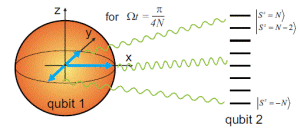Quantum information using Bose-Einstein condensates
Quantum information using Bose-Einstein condensation
Currently quantum computing is being investigated in a variety of different systems, ranging from nonlinear optics, ion traps, superconducting qubits, cold atoms in optical lattices, NV centers in diamond, and semiconductor quantum dots [1]. The range of different systems that are being investigated reflects the early stage technologically that the field is in, where it is still unclear what materials are best in order to make a quantum computer. As is well known, the main difficulty in making a quantum computer is overcoming decoherence where the environment causes what is essentially noise on the quantum state of the qubit register. Although error correcting methods have advanced to a level that gate errors in the vicinity of 1% can be tolerated using topological error correction, as outlined in Ref. [1], the field is still not advanced to a level that a scalable quantum computer can be built.
One of the fundamental difficulties with quantum computing is that quantum states are fundamentally very sensitive to their surroundings. This is typically because the quantum world is associated with the microscopic world, where we must deal with extremely small length scales to observe quantum phenomena. Thus typically to control the states in the qubit register we require control over extremely small objects: atoms, quantum dots, atomic vacancies in crystals, etc. Although classical digital circuitry uses discrete variables in order to perform logic operations, single atoms are of course not used in computers, macroscopic currents are used to encode the logical information. A macroscopic current is first discretized to store the logical information.
A question then arises of whether such a similar approach is possible for quantum computing. Usually this possibility is excluded because quantum effects tend to disappear for macroscopic objects. Typically the quantum effects become smeared out into their classical averages, and thus quantum computing also becomes impossible. There are however exceptions to this general rule. Bose-Einstein condensates (BECs) are one exception where quantum effects are visible on a macroscopic level. For example, in a BEC all the bosons in the system occupy the ground state of the trap. The state of the system then obeys a macroscopic wavefunction obeying the Gross-Pitaevskii equation, which has the same mathematical form as the Schrodinger equation [2]. This similar structure causes the macroscopic wavefunction obey all the same properties as microscopic quantum particles such as superposition and tunneling, but on a macroscopic scale.
How is quantum information then encoded on such BECs? This problem has been investigated by us previously, with a theoretical framework outlined in Ref. [3]. The basic strategy is the use of two component Bose-Einstein condensates. For atomic systems, this corresponds to the use of hyperfine levels of the atoms forming the BECs. The basic wavefunction of such a state is
where are arbitrary coefficients, are the creation operators of the two BEC species, is the number of bosons in the BEC. Such two component BECs can be put in an arbitrary superposition of the two states, in the same way as qubits, and have similar manipulation properties as standard qubits. Importantly, entanglement can be generated between two such qubits, and quantum algorithms can be executed on such qubits.
There are several interesting directions of research we are carrying out in this direction, listed as below
– Quantum algorithm mapping between qubits and BEC qubits
– Decoherence minimizing schemes from creating entanglement between BECs
– Entanglement detection for spin ensembles and BECs
If you would like to find out more about quantum information processing using BECs, I suggest reading Ref. [4] below.
References
[1] T. Ladd et al., Nature 464, 45 (2010).
[2] L. Pitaevskii and S. Stringari, Bose-Einstein condensation (Oxford, 2003).
[3] Tim Byrnes, Kai Wen, Yoshihisa Yamamoto, Phys. Rev A 85 040306(R) (2012).
[4] Tim Byrnes, Daniel Rosseau, Megha Khosla, Alexey Pyrkov, Andreas Thomasen, Tetsuya Mukai, Shinsuke Koyama, Ahmed Abdelrahman, Ebubechukwu Ilo-Okeke, Optics Communications 337, 102 (2014).

